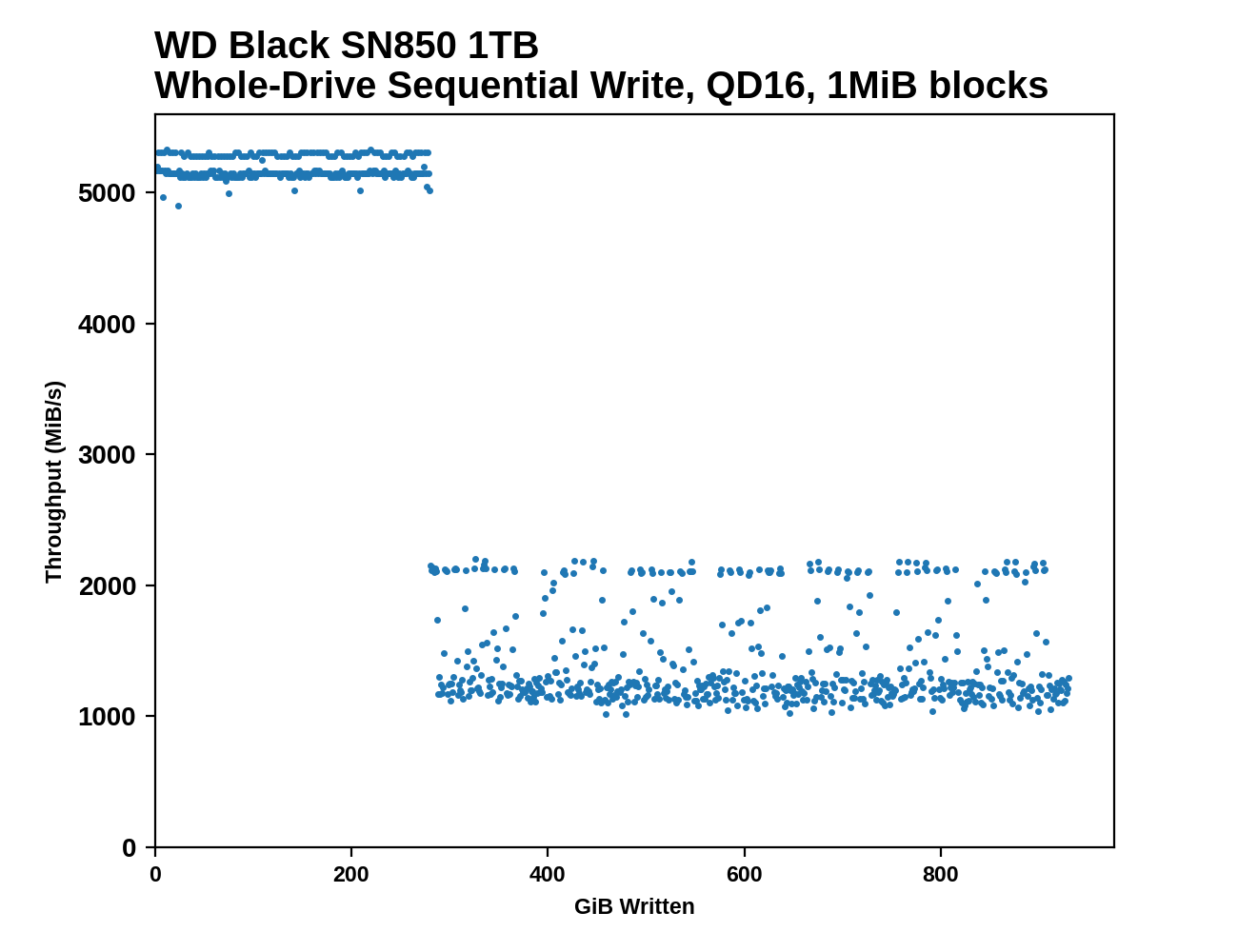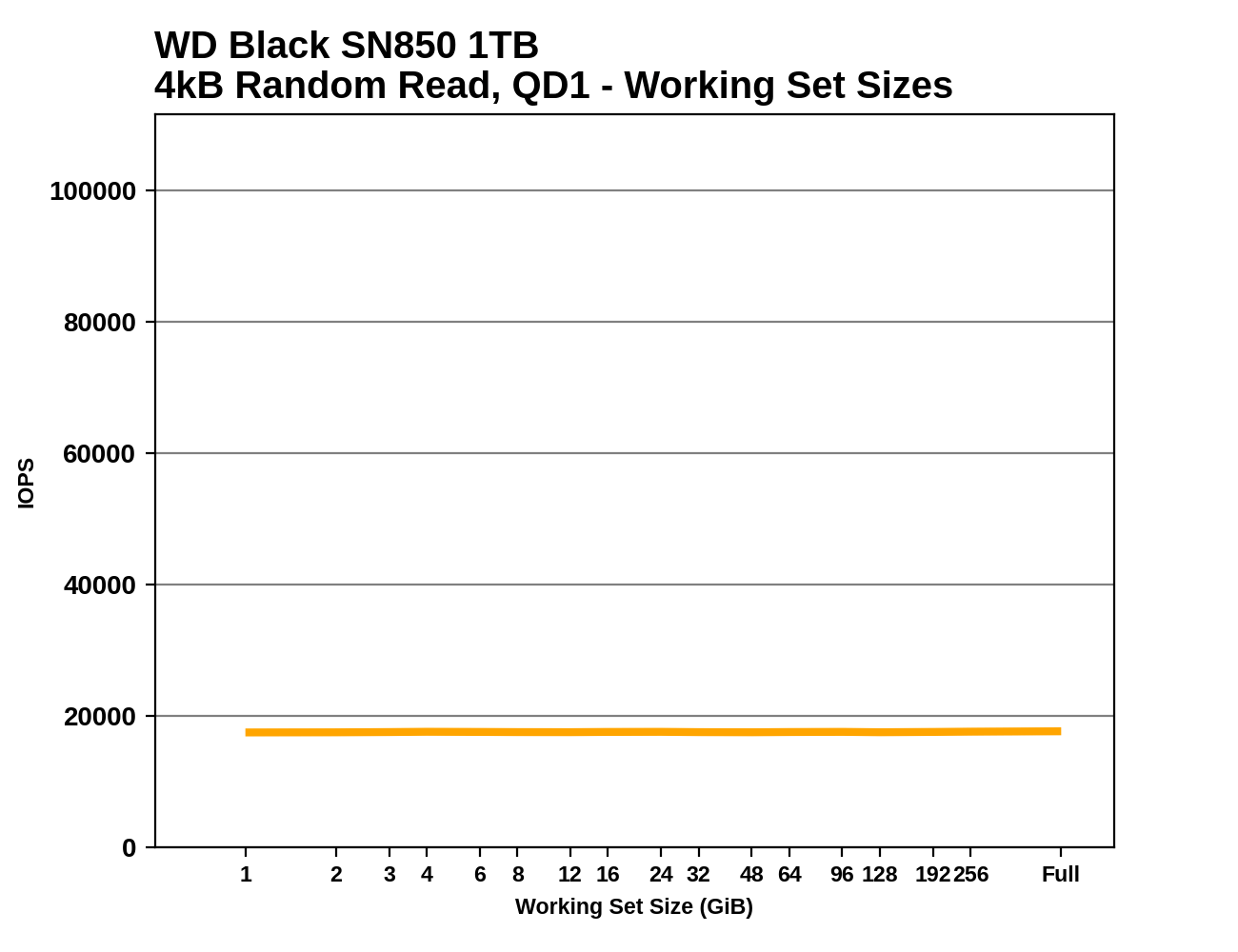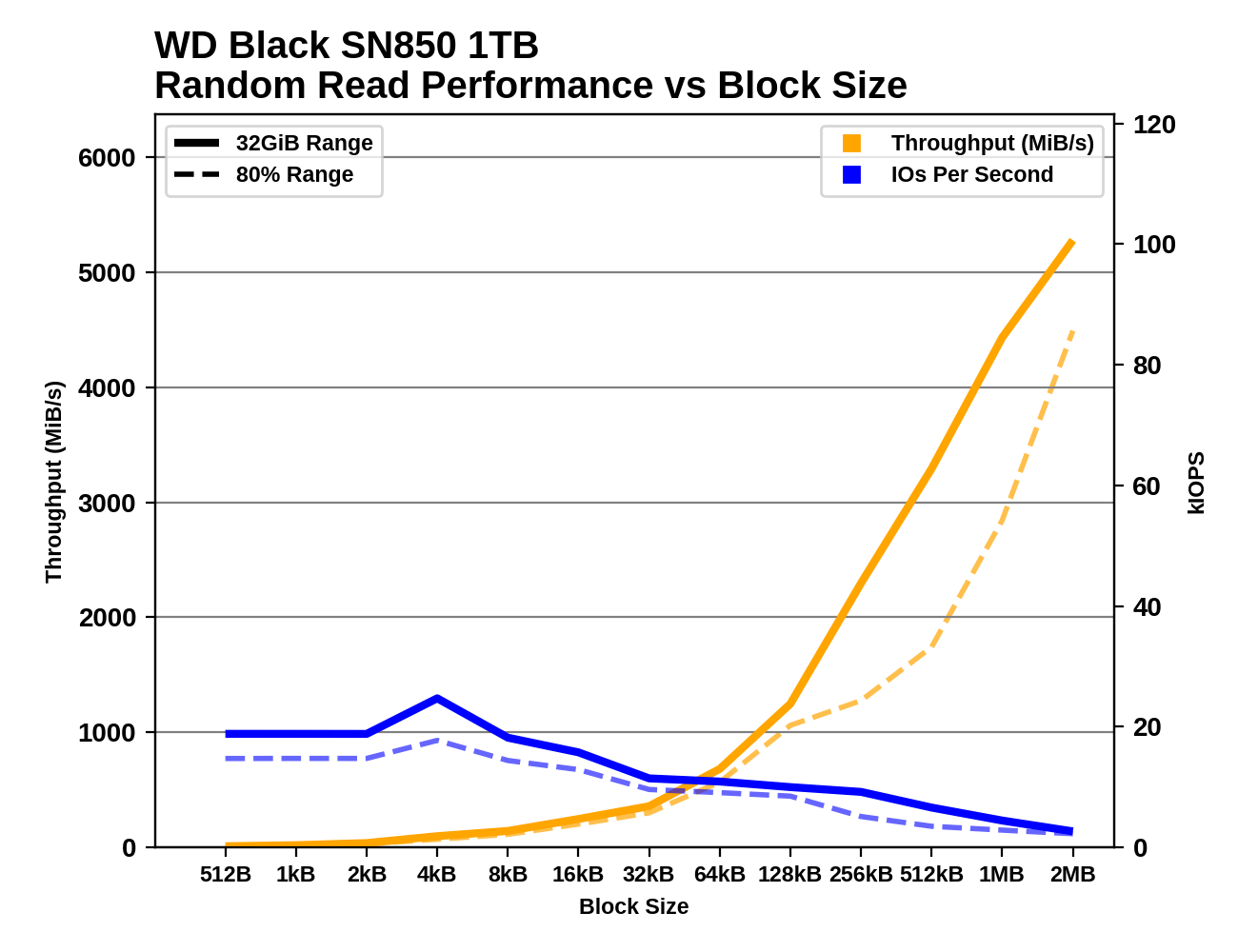The Western Digital WD Black SN850 Review: A Very Fast PCIe 4.0 SSD
by Billy Tallis on March 18, 2021 12:50 PM ESTAdvanced Synthetic Tests
Our benchmark suite includes a variety of tests that are less about replicating any real-world IO patterns, and more about exposing the inner workings of a drive with narrowly-focused tests. Many of these tests will show exaggerated differences between drives, and for the most part that should not be taken as a sign that one drive will be drastically faster for real-world usage. These tests are about satisfying curiosity, and are not good measures of overall drive performance. For more details, please see the overview of our 2021 Consumer SSD Benchmark Suite.
Whole-Drive Fill
 |
|||||||||
| Pass 1 | |||||||||
| Pass 2 | |||||||||
On the first pass starting from an empty drive, the WD Black SN850's SLC cache handles sequential writes at a bit over 5GB/s and the cache lasts for about 281GB before running out. That's a very large SLC cache size for a TLC drive, which is probably why performance is so variable after the cache is full. For the second pass of sequential writes, the cache size has been reduced to about 20GB, but the drive shows a second burst of 20GB of SLC-speed writes later in the test.
 |
|||||||||
| Average Throughput for last 16 GB | Overall Average Throughput | ||||||||
The aggressive SLC caching behavior on the SN850 comes at the cost of slower and less-consistent post-cache write performance, but Western Digital's earlier WD Black SSDs already behaved quite well here. The SN850 manages to keep write speed from ever dropping below 1GB/s, and the overall average across the entire drive fill is basically the same as the SN730, the OEM relative to the SN750 but with the same newer flash as the SN850.
On the second sequential write pass when the SN850's variable-size SLC cache is already at its smallest, post-cache performance is extremely consistent and faster than any other TLC SSD we have tested, but still 15% slower than the MLC-based Samsung 970 PRO.
Working Set Size
 |
|||||||||
Most high-end drives have boring and steady results on this test since they don't skimp on DRAM. The QD1 random read latency for the SN850 is better than any other TLC drive we've tested, and only 4% slower than the MLC-based Samsung 970 PRO.
Performance vs Block Size
 |
|||||||||
| Random Read | |||||||||
| Random Write | |||||||||
| Sequential Read | |||||||||
| Sequential Write | |||||||||
The WD Black SN850 is strongly optimized for 4kB IOs, with lower IOPS and throughput for sub-4kB block sizes on all four workloads. None of the other drives show such broad preferences for 4kB block sizes, but some of Western Digital's drives and a few others show this behavior on at least some of the workloads. This tuning pays off in some places, such as the SN850's leading random write performance for small block sizes (which is followed by the SLC cache running out while testing larger block random writes). There are some other weaknesses including poor performance for small-block sequential reads, but more importantly it has great performance for sequential reads with larger block sizes.










83 Comments
View All Comments
Duncan Macdonald - Thursday, March 18, 2021 - link
For people who want performance and endurance above price, it would be nice if one of the major manufacturers made a variant with a firmware change that used the NAND in SLC mode only. This would reduce the capacity to 1/3 of the usual TLC mode but would give the same speed as SLC cache mode for the whole of the drive. (No hardware change would be needed - just different firmware for the controller.)jamesindevon - Friday, March 19, 2021 - link
You could get something like the Sabrent Rocket Q, and leave 75% of it unpartitioned. The Anandtech review makes it clear that in that mode, it will use the other 25% as SLC.https://www.anandtech.com/show/16136/qlc-8tb-ssd-r...
ichaya - Friday, March 19, 2021 - link
I was looking for something just like this, it's this or Optane, and if QLC/TLC drive manufacturers did offer this in firmware or partitioning, Optane for consumers might as well be dead.FunBunny2 - Friday, March 19, 2021 - link
"firmware change that used the NAND in SLC mode only"I seem to recall, likely here, that SLC mode for [M/T/Q]LC NAND isn't near the performance of 'real' SLC NAND. anyone?
Fujikoma - Monday, March 29, 2021 - link
SLC=2/MLC=4/TLC=8/QLC=16... would be 1/4. Personally would be happy if they offered MLC for the enthusiast versions.eastcoast_pete - Thursday, March 18, 2021 - link
Thanks Billy!One aspect of this and the other PCIe 4.0 drives I have been wondering about is: do they really need 4 lanes to reach their full speed? The reason for my question is that I can imagine situations (e.g. Intel's Rocket Lake) where only 20 or even fewer total 4.0 lanes are available, and having 2 lanes more left for other uses might make a difference. So, are those 4 PCIe 4.0 lanes per drive really needed for full speed of this and similar SSDs?
James5mith - Thursday, March 18, 2021 - link
Yes. 4x PCIe4.0 lanes is ~8GB/s full duplex bandwidth (2GB/s per lane). These drives are hitting 7+GB/s of bandwidth at max utilization.James5mith - Thursday, March 18, 2021 - link
I've been Really enjoying the performance of my new Sabrent Rocket 4 Plus. I think Anandtech should add it to the comparisons for PCIe 4.0 drives going forward.James5mith - Thursday, March 18, 2021 - link
https://www.sabrent.com/product/SB-RKT4P-4TB/4tb-r...Unashamed_unoriginal_username_x86 - Thursday, March 18, 2021 - link
... Is this astroturfing?